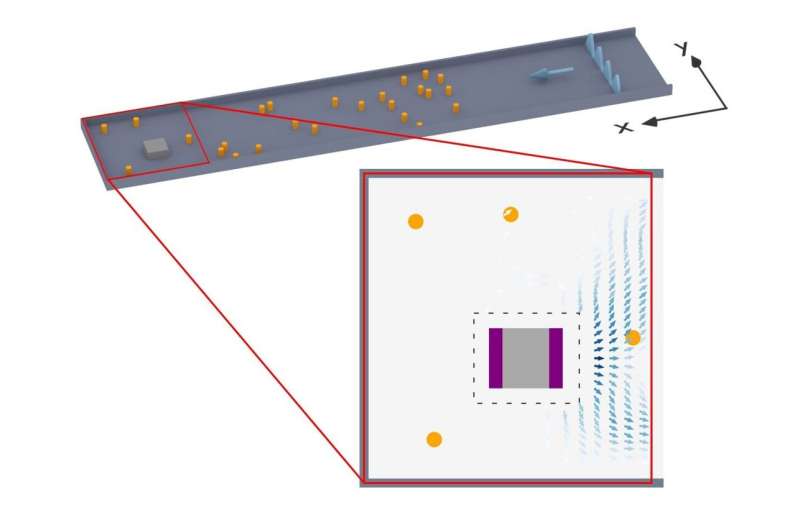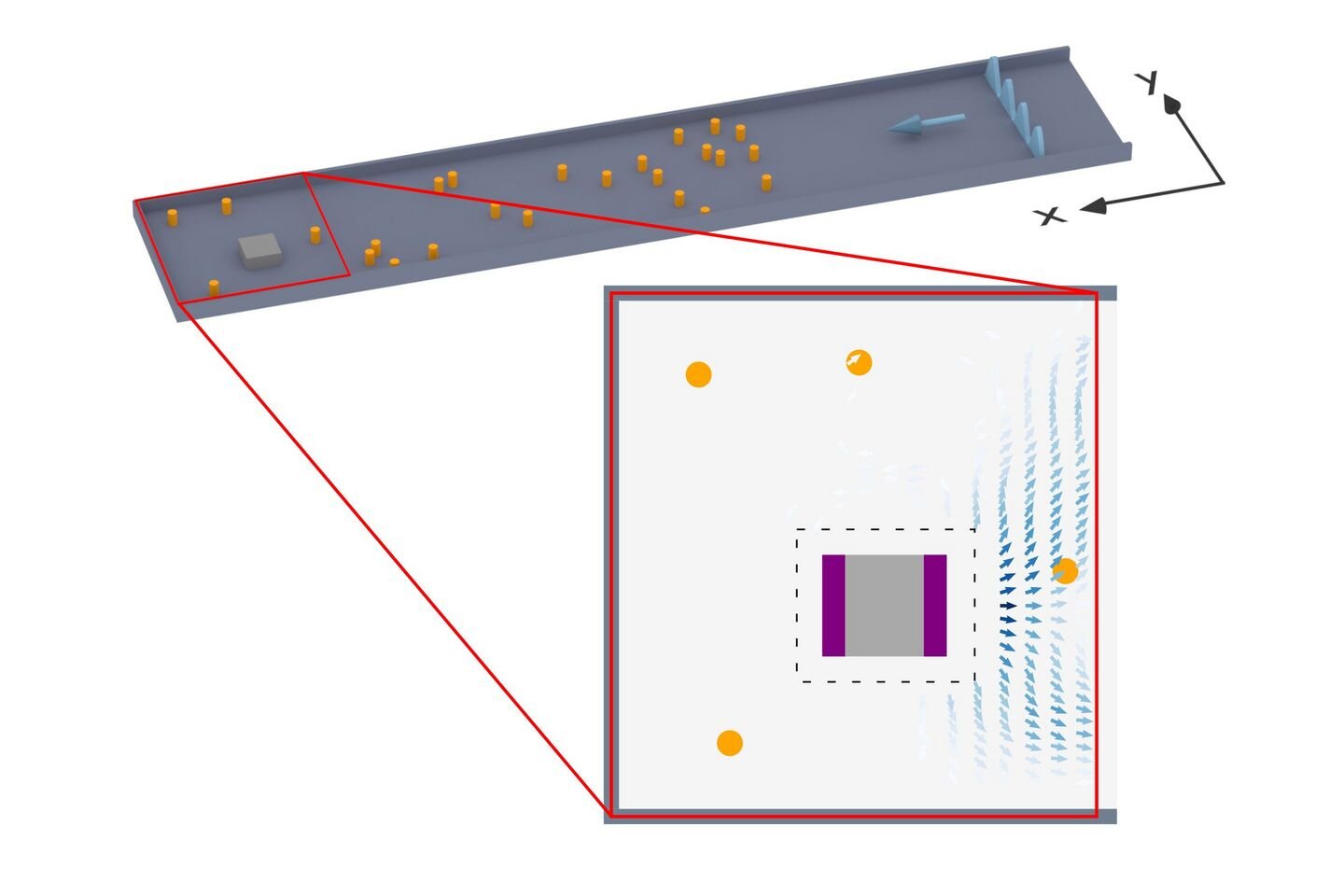
Teflon objects (orange cylinders) were placed in a waveguide with a rectangular cross section. Then, an electromagnetic signal (blue wavefront) was injected from the right to extract information about the metallic cuboid shown in gray. By measuring the wave field in the area shown in red, researchers can show how information is generated and transported by an electromagnetic signal. For example, the flow of information about the horizontal position of the cuboid is shown in the lower right (blue arrows). One sees that the information is generated on the right side of the cuboid and then transported to the right towards the waveguide aperture. Credit: Nature Physics (2024). DOI: 10.1038/s41567-024-02519-8
Waves receive information from their environment through which they propagate. A theory of information carried by waves has now been developed at the TU Wien – with amazing results that can be used for technical applications.
Ultrasound is used to analyze the body, radar systems to study airspace or seismic waves to study the interior of our planet. Many areas of research deal with waves being deflected, scattered, or reflected by their surroundings. As a result, these waves carry a certain amount of information about their environment, and this information must be extracted as comprehensively and accurately as possible.
The search for the best way to do this has been the subject of worldwide research for many years. TU Wien has now succeeded in describing the information carried by a wave about its environment with mathematical precision. This has made it possible to show how waves pick up information about an object and then transport it to a measuring device.
This can now be used to generate custom waveforms to extract the maximum amount of information from the environment – for example, for more accurate imaging processes. This theory was confirmed by microwave experiments. The results were published in the journal Nature Physics.
Where exactly is the information located?
“The basic idea is quite simple: you send a wave at an object and the part of the wave that is scattered by the object is measured with a detector,” says Prof Stefan Rotter from the Institute of Theoretical Physics at TU Wien.
“The data can then be used to learn something about the object – for example, its exact position, speed or size.” This information about the environment that this wave carries is known as “Fisher Information”.
However, it is often not possible to catch the whole wave. Usually, only part of the wave reaches the detector. This begs the question: Where exactly does this information reside on the wave? Are there parts of the wave that can be safely ignored? Perhaps a different waveform would give more information to the detector?
“To get to the bottom of these questions, we took a closer look at the mathematical properties of this Fisher information and came up with some surprising results,” says Rotter.
“Information satisfies a so-called continuity equation – information in waves is conserved as it moves through space, according to laws that are very similar to conservation of energy, for example.”
An understandable way of information
Using the newly developed formalism, the research team has now been able to calculate exactly at which point in space the wave actually carries how much information about the object. It turns out that information about different properties of the object (such as position, velocity and size) can be hidden in completely different parts of the wave.
As theoretical calculations show, the information content of the wave depends precisely on how strongly the wave is affected by certain properties of the object under investigation.
“For example, if we want to measure whether an object is slightly further to the left or slightly further to the right, then the Fisher information is carried exactly by the part of the wave that comes into contact with the right and left ends. of the object,” says Jakob Hüpfl, the doctoral student who played a key role in the study.
“This information is then propagated, and the more of this information reaches the detector, the more accurately the position of the object can be read by it.”
Microwave experiments confirm the theory
In Ulrich Kuhl’s group at the University of the Cote d’Azur in Nice, the experiments were carried out by Felix Russo as part of his master’s thesis: A disordered environment was created in a microwave chamber using randomly positioned Teflon objects. A metal rectangle was placed between these objects, the position of which had to be determined.
Microwaves were sent through the system and then picked up by a detector. The question now was: How well can the position of the metal rectangle be inferred from the waves picked up in the detector in such a complicated physical situation, and how does the information flow from the rectangle to the detector?
By accurately measuring the microwave field, it was possible to show exactly how the information about the horizontal and vertical position of the rectangle is propagated: it originates from the corresponding edges of the rectangle and then moves along with the wave – without losing any information. as predicted by the newly developed theory.
Potential applications in many fields
“This new mathematical description of Fisher information has the potential to improve the quality of a variety of imaging methods,” says Rotter. If it is possible to quantify where the desired information is located and how it propagates, then it becomes possible, for example, to position the detector more appropriately or calculate custom waves that carry the maximum amount of information to the detector.
“We tested our theory with microwaves, but it is equally valid for a wide variety of waves of different wavelengths,” Rotter points out. “We provide simple formulas that can be used to improve microscopy methods as well as quantum sensors.”
More information:
Jakob Hüpfl et al, Continuity equation for Fisher information flow in wavelet scattering, Nature Physics (2024). DOI: 10.1038/s41567-024-02519-8
Provided by Vienna University of Technology
citation: New theory describes how waves carry information from surroundings (2024, June 12) retrieved June 12, 2024 from https://phys.org/news/2024-06-theory.html
This document is subject to copyright. Except for any fair agreement for study or private research purposes, no part may be reproduced without written permission. The content is provided for informational purposes only.
